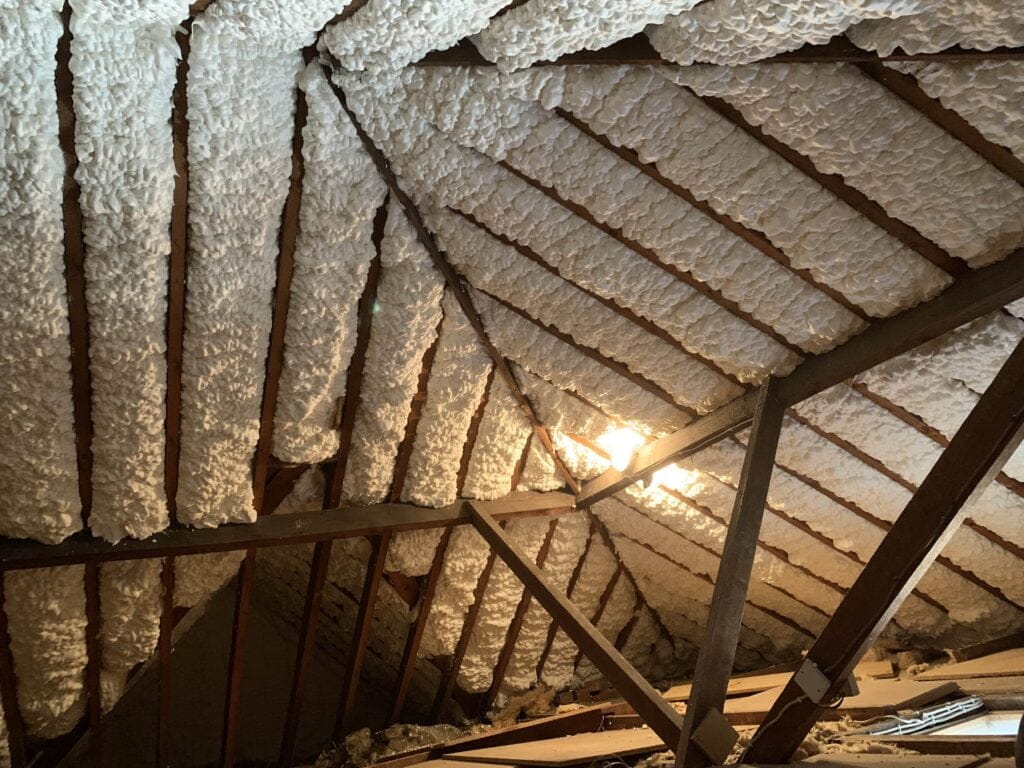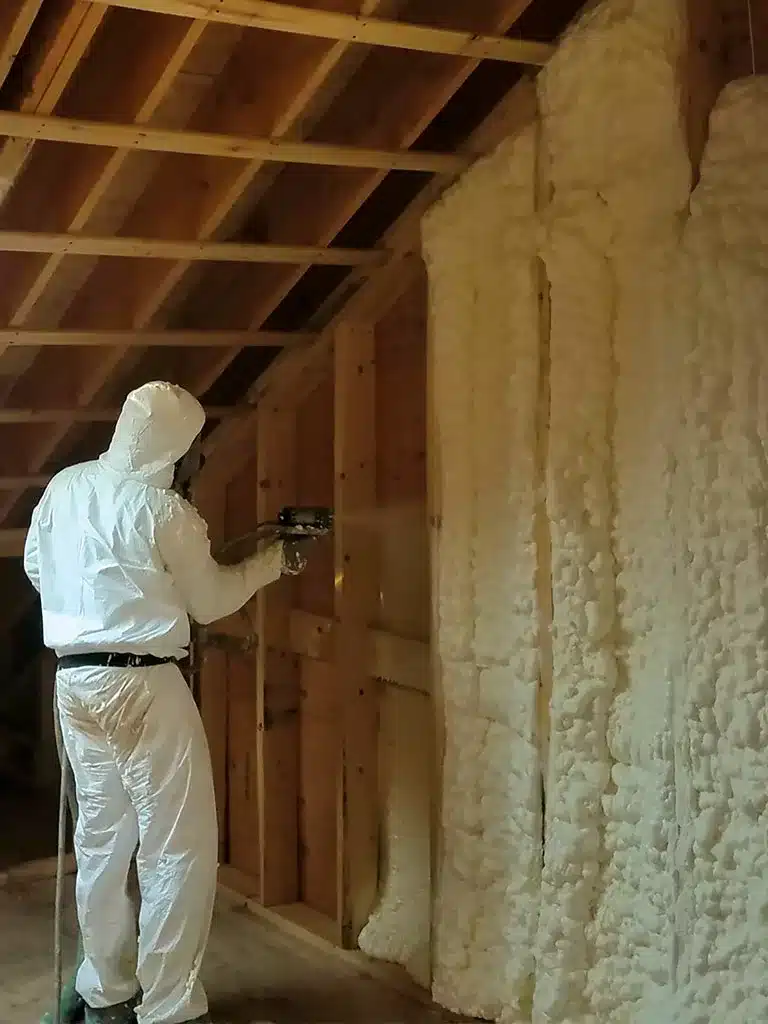Recognizing the Benefits of Using Spray Foam for Insulation Projects
Recognizing the Benefits of Using Spray Foam for Insulation Projects
Blog Article
Spray Foam: The Ultimate Service for Air Sealing and Insulation
Spray foam insulation has actually emerged as a leading solution for efficient air sealing and thermal insulation, supplying a distinct mix of residential properties that set it apart from typical approaches. Comprehending the complete scope of its benefits, setup procedures, and comparisons with various other insulation types is critical for making informed choices.
What Is Spray Foam?
Spray foam is a versatile insulation product that incorporates the principles of air securing and thermal resistance to enhance energy performance in buildings. Composed largely of polyurethane or other similar substances, spray foam is used as a liquid that broadens upon call with surfaces, producing a strong, continual layer of insulation. This distinct building allows it to fill up voids, cracks, and voids that standard insulation products might overlook, offering a premium air seal.
There are two main kinds of spray foam: open-cell and closed-cell. Open-cell spray foam is lighter and extra adaptable, offering outstanding noise absorption and a reduced R-value per inch - Spray Foam. In comparison, closed-cell spray foam is denser, providing a higher R-value, wetness resistance, and included architectural stability to constructing parts
The application procedure commonly involves customized devices, making certain a smooth application that abides by different substrates, including timber, metal, and concrete. This versatility makes spray foam appropriate for both new buildings and retrofitting existing structures. Its ability to create an impermeable obstacle dramatically adds to lowering power usage and enhancing indoor air top quality, therefore making it a recommended option among property owners and builders alike.
Advantages of Spray Foam Insulation
Among the most significant benefits of spray foam insulation is its phenomenal capability to create a continual air barrier, which effectively decreases energy loss. Unlike traditional insulation products, spray foam broadens to load splits and gaps, making certain that air leakage is significantly lowered. This characteristic not just improves power effectiveness yet likewise leads to reduce energy bills with time.
Additionally, spray foam insulation gives exceptional thermal resistance, adding to a more steady interior environment. Its high R-value per inch enables reliable insulation in confined areas, making it ideal for attics, wall surfaces, and crawl rooms. The moisture-resistant residential properties of spray foam aid prevent mold and mildew development, advertising much healthier living problems.
Another vital advantage of spray foam insulation is its sound-dampening top qualities (Spray Foam). It effectively reduces noise transmission between rooms, creating a quieter and much more comfortable home atmosphere. The longevity of spray foam additionally stands out, as it does not sag or settle over time, maintaining its performance throughout its lifespan
How Spray Foam Functions
Recognizing just how spray foam insulation functions is crucial for valuing its efficiency in air sealing and thermal resistance. Spray foam insulation includes two key parts: isocyanate and polyol material. When these elements are blended, they undergo a chemical reaction that creates the product to broaden quickly, creating a thick foam that fills up dental caries, spaces, and cracks.
As the foam increases, it sticks to surfaces, creating a closed seal that significantly lowers air infiltration. This characteristic makes spray foam insulation extremely effective at preventing drafts and wetness penetration, which can bring about energy loss and damages in time. In addition, the closed-cell variation of spray foam offers remarkable thermal resistance due to its inflexible structure, successfully minimizing warmth transfer.
The distinct properties of spray foam enable it to comply with irregular surface areas, ensuring detailed coverage and a seamless obstacle. Therefore, spray foam insulation not only improves power efficiency however additionally contributes to enhanced indoor air top quality by reducing the build-up of pollutants and allergens. Inevitably, recognizing the mechanics behind spray foam highlights its function as a premium choice for insulation and air sealing in both business and household applications.
Installment Refine Introduction

Before setup, the area needs to be appropriately cleansed and prepped, making certain that surfaces are devoid of debris, dust, and wetness. This action is crucial because contaminants can compromise adhesion and overall efficiency. Once the location is prepared, the application entails mixing both components of the spray foam, which expands upon call and loads spaces efficiently.
Trained other professionals need to perform the setup, utilizing specialized tools to make certain uniform coverage and optimum thickness. Safety precautions, consisting of using safety equipment and guaranteeing correct air flow, are crucial during this procedure. After application, the foam usually cures promptly, developing a solid barrier that boosts energy performance.
Comparing Spray Foam to Conventional Insulation
When assessing insulation alternatives, spray foam insulation stands out in comparison to conventional products such as fiberglass and cellulose. Unlike fiberglass and cellulose, which can permit air infiltration, spray foam expands upon application, filling up crevices and spaces to create an impermeable seal.
Additionally, spray foam supplies a greater R-value per inch than typical insulation kinds, offering more efficient thermal resistance in a thinner account. This particular is specifically advantageous in areas with restricted dental caries deepness. Spray foam is resistant to wetness and mold growth, which can be a significant concern with cellulose and fiberglass, particularly in humid environments.
However, spray foam insulation typically carries a greater ahead of time price than its standard equivalents. House owners should evaluate this initial financial investment versus long-lasting energy savings and efficiency advantages. Eventually, while both insulation types offer their objective, spray foam emerges as a more innovative remedy for contemporary insulation requirements, particularly in regards to air securing and thermal efficiency.

Verdict
In my review here recap, spray foam insulation represents an extremely efficient service for achieving ideal air sealing and thermal resistance. Its unique residential properties, consisting of moisture resistance and sound dampening, make it appropriate for different applications in both new constructions and retrofitting tasks (Spray Foam). Although the first prices might be higher compared to typical insulation products, the lasting benefits, such as substantial power financial savings and boosted indoor air quality, warrant the financial investment and highlight its value in modern-day building practices.
Spray foam insulation has arised as a leading solution for efficient air sealing and thermal insulation, using a distinct mix of residential or commercial properties that set it apart from typical techniques.Spray foam is a versatile insulation material that incorporates the principles of air securing and thermal resistance to enhance power efficiency in buildings.When reviewing insulation choices, spray foam insulation stands out in contrast to traditional products such as fiberglass and cellulose. Inevitably, while both insulation types offer their objective, spray foam emerges as a much more innovative service for modern-day insulation needs, especially in terms of air securing and thermal efficiency.
In summary, spray foam insulation stands for a very effective service for attaining optimal air sealing and thermal resistance.
Report this page